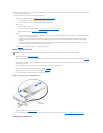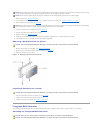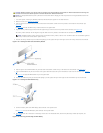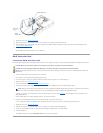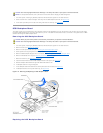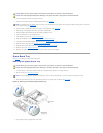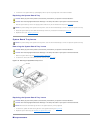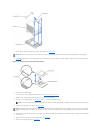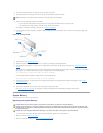
To take advantage of future options in speed and functionality, you can add a second microprocessor or replace either the primary or secondary
microprocessor.
Each microprocessor and its associated cache memory are contained in a PGA package that is installed in a ZIF socket on the system board.
The following items are included in the microprocessor upgrade kit:
l A microprocessor
l A heat sink
l Two securing clips
l A cooling fan
l A VRM, if adding a second microprocessor
Adding or Replacing a Microprocessor
1. Turn off the system, including any attached peripherals, and disconnect the system from the electrical outlet.
2. Remove the cover (see "Removing the Cover").
If you are installing a second microprocessor, go to step 6.
3. Remove the microprocessor heat sink:
a. Press down on the heat-sink securing clips to release the clips from the retaining tabs on the ZIF socket (see Figure4-27).
b. Remove the heat sink securing clips.
c. Remove the heat sink.
Figure 4-27. Removing and Installing the Heat Sink
NOTICE: The second microprocessor must be of the same type as the first. If the two microprocessors are different speeds, both will operate at the
speed of the slower microprocessor.
NOTE: A microprocessor must be installed in socket 1, and a VRM must be installed for each installed microprocessor. To identify microprocessors and
VRMs, see Figure5-3.
NOTE: In a single microprocessor system, the microprocessor must be installed in the PROC 1 socket.
CAUTION: Before you perform this procedure, read the safety instructions in your System Information document.
CAUTION: See "Protecting Against Electrostatic Discharge" in the safety instructions in your System Information document.
NOTE: The system is designed to allow you to remove the microprocessor heat sink without removing the microprocessor cooling fan. However,
you can remove the fan to provide easier access to the heat sink retention clips (see "Removing a Cooling Fan").
CAUTION: The microprocessor and heat sink can become extremely hot. Be sure the microprocessor has had sufficient time to cool before
handling.
NOTICE: Never remove the heat sink from a microprocessor unless you intend to remove the microprocessor. The heat sink is required to maintain
proper thermal conditions.
NOTICE: After removing the heat sink, place it upside down on a flat surface to prevent the thermal interface material from being damaged or
contaminated.



